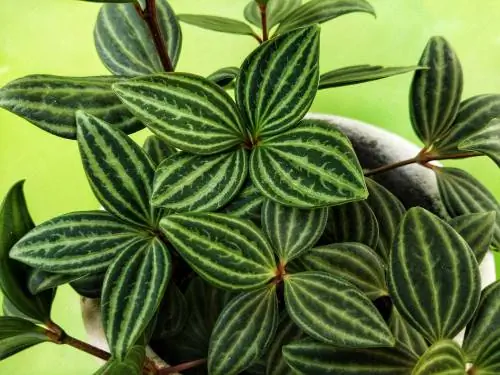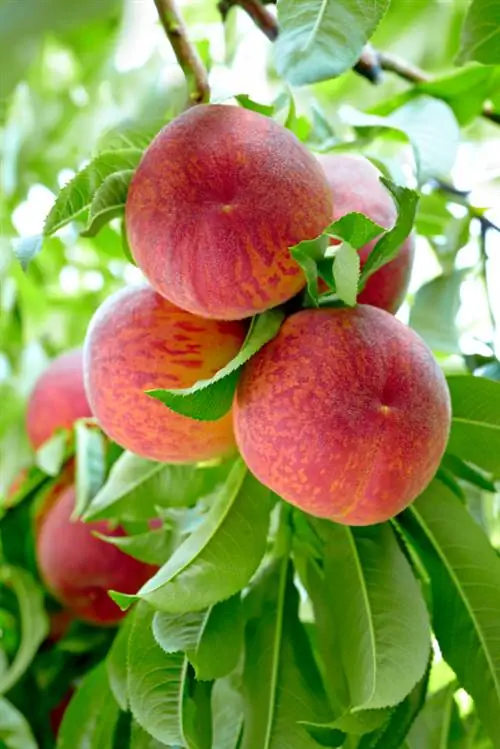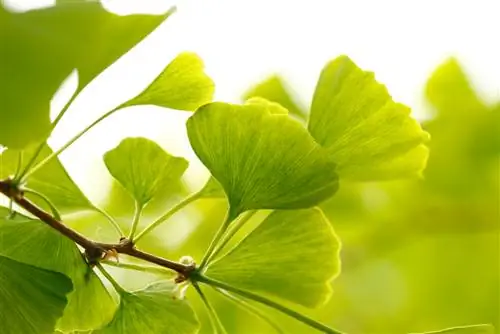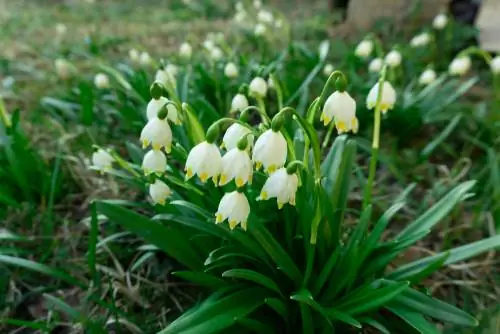- Author admin [email protected].
- Public 2023-12-16 16:46.
- Last modified 2025-01-23 11:21.
The dwarf or ornamental pepper (bot. Peperomia) is an ornamental plant with thick-fleshed leaves that comes from the tropics. There are around 1,500 different species and varieties that differ from each other in shape and color, but none of them grow to a height of more than 30 centimeters. The decorative fleshy dwarf pepper (bot. Peperomia obtusifolia) is particularly popular as a houseplant, as it does not require much care in the right location.

What is the dwarf pepper and how do I care for it?
Dwarf pepper (Peperomia) is a tropical ornamental plant native to the Amazon region of South America. It has thick-fleshed leaves and reaches heights of 15 to 30 centimeters. As a houseplant, it is easy to care for and prefers bright, indirect lighting conditions as well as uniform temperature and humidity.
Origin and distribution
The dwarf pepper belongs to a large family of around 1,500 different species and is botanically closely related to the well-known kitchen spice. The pretty decorative foliage plant has its home in the South American Amazon region, where it prefers to be found under the warm shade of large jungle trees. But various varieties can also be found in other tropical to subtropical areas of Central and South America. What they all have in common is the need for a warm culture all year round, which is why the plant is only suitable for indoor cultivation and not for the garden.
Appearance and growth
The stocky perennial forms a dense clump. Dwarf pepper - as the name suggests - does not grow particularly large and only reaches heights of between 15 and 30 centimeters. The thick, fleshy leaves vary greatly in shape and color depending on the species and variety and can range from a solid fresh green to yellow or white-green variegated. With different varieties of the dwarf pepper you can create small collections on the windowsill.
leaves
Peperomias - which are sometimes also called watermelon plants, rat tails or crocodile tears - are extremely decorative foliage plants that are wonderful for smaller windowsills. The five to eight centimeters long and elliptically shaped leaves are fleshy and have a leathery texture. The leaf blade is shiny in all varieties, regardless of the varied coloring of the leaves.
Flowers and flowering time
In contrast to the attractive foliage of the dwarf pepper, the piston-shaped flower spikes are very small and are hardly noticeable. The light green to yellowish-white flowers usually appear between April and December.
Fruits
The delicate flowers develop into equally inconspicuous, small berries.
Toxicity
Dwarf pepper is not poisonous, but is actually very suitable for planting in terrariums. Reptiles love to eat the juicy leaves.
Which location is suitable?
Although peperomias don't need much care, they do need a suitable location. The plants should be placed on a windowsill in a bright, but not directly sunny place, although varieties with colorful leaves generally need more light than monochromatic ones. However, be sure to avoid direct sunlight, as this will cause leaf burns and therefore unsightly brown spots. Since the decorative foliage plant does not tolerate temperature fluctuations, drafts should also be avoided. The optimal room temperature is around 20 degrees Celsius all year round, although it should never get colder than 18 degrees Celsius.
The dwarf pepper can also spend the summer months in a bright but sunny spot on the balcony or terrace. However, be sure to bring the plant inside as soon as it gets consistently cooler than 18 degrees Celsius, is windy or stormy, or frequently rains heavily.
Substrate
Plant the dwarf pepper in commercially available green plant or pot plant soil, which should not be based on peat for environmental reasons. Compost soil is a little more expensive, but the plants thrive much better in it. For better permeability, add expanded clay or other inorganic materials to the substrate; good pot drainage is also essential to avoid waterlogging. To do this, fill the bottom of the pot with a layer of gravel or expanded clay a few centimeters thick.
Planting and repotting
Peperomias are the right choice if there is little space in the apartment for houseplants. The shallow-rooted plants only develop a few roots and therefore make do with small planters and hanging baskets. Furthermore, several specimens can be placed in groups in a larger pot. And this is how it is planted:
- Fill the drainage layer into the pot.
- Fill the plant substrate on top.
- Push in a planting hole with your fingers.
- Put the dwarf pepper in it.
- Press the plant lightly.
- Water lightly.
- The substrate should be moist but not wet.
Repot the plants in fresh substrate once a year in early summer; a larger planter is not always necessary. Do not choose a plant pot that is too large, otherwise the small plants will look very lost in it. If peperomias are fully grown and no longer getting any bigger, it is sufficient to simply change the top layer of soil.
Watering dwarf pepper
Ideally, the dwarf pepper grows in a substrate that is always slightly moist, but never wet. Before each watering, do a finger test: If the soil in the pot feels dry and crumbly on the surface, it is time for another swing from the watering can. Use stale tap water or collected rainwater for this, as dwarf pepper, like so many tropical plants, does not tolerate lime. Excess water from the planter or saucer should be removed immediately.
Fertilize dwarf peppers properly
Since dwarf pepper only needs a few nutrients (and is repotted into fresh substrate every year anyway), always fertilize the plants in low doses. It is best to use a liquid fertilizer (€14.00 on Amazon) for houseplants or green plants, which you administer together with the irrigation water. Fertilization is carried out every two weeks during the main growing season between April and October, but only every four weeks during the cold season.
cutting dwarf peppers correctly
Pruning measures are neither necessary nor useful, especially since the dwarf pepper achieves its pleasing growth habit without the help of scissors. You should only carefully pick off dry or wilted leaves with your fingers.
Propagate dwarf peppers
The easy-care pepper plants can be easily propagated using head or leaf cuttings. These are best cut in spring or during the summer months. And this is how cuttings can be propagated:
- Cut head cuttings about ten centimeters long.
- Make the cut directly below a leaf node.
- The roots will grow from this later.
- Remove all leaves at the bottom of the shoot.
- Plant the cuttings individually in small pots.
- Fill this with a mixture of potting soil and gravel/expanded clay.
- Wet the substrate.
- Put a cut PET bottle over the cutting.
- Alternatively, a stretched transparent film also works.
- Place the pots in a bright, sunny and warm location.
- Air daily.
- Keep the substrate only slightly moist.
Within two to three months, most cuttings have completely rooted and can be repotted if necessary.
Wintering
Special measures for overwintering are not necessary, as peperomias should be kept warm all year round. However, due to the lower amount of light during the winter, you should water and fertilize the plants less often.
Diseases and pests
The dwarf pepper reacts quite sensitively to excessive moisture or even waterlogging. This promotes root rot and also causes leaves and shoots to rot. Otherwise, the pests that are typical of indoor culture keep coming back, although these can be easily controlled. It therefore makes sense to regularly check for spider mites, mealybugs, mealybugs and thrips and to take appropriate measures promptly in the event of an infestation. Diseased plants should also be separated for the duration of treatment to prevent them from jumping to he althy ones.
Tip
Since the ornamental pepper should be kept out of the sun anyway, you can also cultivate it in darker corners of the room. Plant lights installed here provide the necessary brightness. The same applies to planting in terrariums. Combine different looking varieties together in a bowl or other flat planter.
Species and varieties
Dwarf peppers are available in around 1,500 (some sources also state up to 1,700) different types, many of which can be cultivated in the living room at home. The numerous varieties are very diverse in their leaf shapes and colors. Peperomias are not only available with green or colorful (variegated) leaves, but also with reddish-brown, red, silvery or striped foliage. The leaves can be fleshy, thick, but also thin, smooth or wrinkled. In addition to the upright growing species, there are also creeping and hanging forms that are very suitable for hanging basket culture.
Peperomia argyreia
This species is also called the watermelon plant and comes from northern South America, where it occurs primarily in the forests of Bolivia, Brazil, Ecuador and Venezuela. The thick, broad and tapered leaves are striking due to their attractive silvery-green stripes. The red petioles of the species, which are up to 40 centimeters high, provide an interesting contrast.
Peperomia caperata
The species native to Brazil is also known as wrinkled or emerald green peperomia. Its heart-shaped leaves are strongly wavy and uniformly dark green. The petioles are also reddish in color. This ornamental pepper remains quite small with a height of only approx. 25 centimeters.
Peperomia fraseri
The species native to Ecuador and Peru has the German name ivy-leaved ornamental pepper. It produces numerous small, rounded leaves that are reddish on the underside. However, the up to 65 tall, lightly scented flower spikes are particularly attractive.
Peperomia griseoargentea (syn. Peperomia hederifolia)
The species, which only grows to around 15 centimeters high, has pretty, silvery shimmering foliage and delights with flower spikes that grow up to 25 centimeters high.
Peperomia obtusifoli
The fleshy ornamental pepper is available in numerous varieties and usually reaches a height of up to 35 centimeters. For example, the following are particularly pretty:
- ‘Alba’: new leaves are colored yellow
- 'Alba-marginata': light foliage with silvery border
- ‘Green’: monochromatic fresh green foliage
- ‘Raindrop’: monochromatic fresh green foliage
- ‘USA’: pretty variant with yellow-green foliage
- 'Variegata': yellow-green variegated foliage






